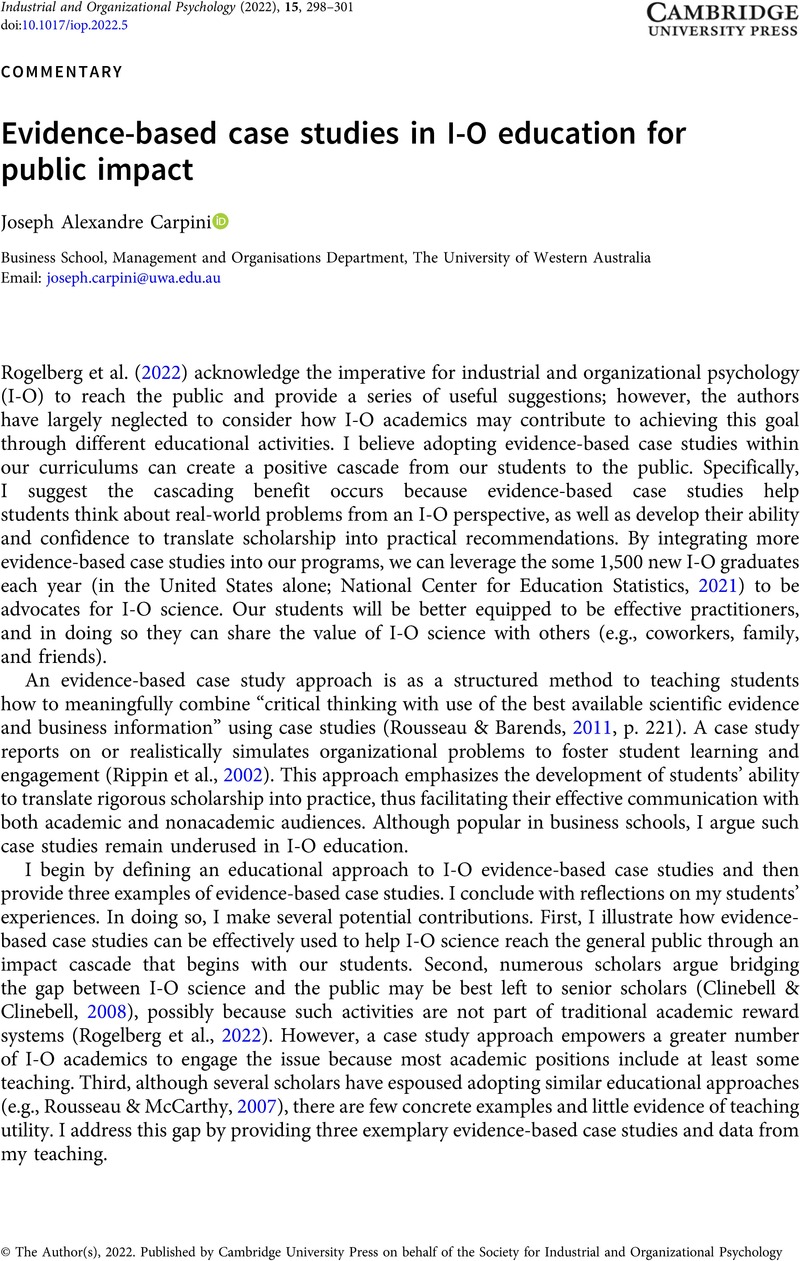No CrossRef data available.
Article contents
Evidence-based case studies in I-O education for public impact
Published online by Cambridge University Press: 26 May 2022
Abstract
An abstract is not available for this content so a preview has been provided. Please use the Get access link above for information on how to access this content.

- Type
- Commentaries
- Information
- Copyright
- © The Author(s), 2022. Published by Cambridge University Press on behalf of the Society for Industrial and Organizational Psychology
References
Byrne, Z. S., Hayes, T. L., Mort McPhail, S., Hakel, M. D., Cortina, J. M., & McHenry, J. J. (2014). Educating industrial-organizational psychologists for science and practice: Where do we go from here? Industrial and Organizational Psychology: Perspectives on Science and Practice, 7(1), 2–14. https://doi.org/10.1111/iops.12095
CrossRefGoogle Scholar
Charlier, S. D., Brown, K. G., & Rynes, S. L. (2011). Teaching evidence-based management in MBA programs: What evidence is there? Academy of Management Learning and Education, 10(2), 222–236. https://doi.org/10.5465/AMLE.2011.62798931
CrossRefGoogle Scholar
Clinebell, S. K., & Clinebell, J. M. (2008). The tension in business education between academic rigor and real-world relevance: The role of executive professors. Academy of Management Learning and Education, 7(1), 99–107.CrossRefGoogle Scholar
Leenders, M. R., & Erskine, J. A. (1989). Case research: The case writing process (3rd ed.). University of Western Ontario.Google Scholar
National Center for Education Statistics. (2021). Bachelor’s, master’s, and doctor’s degrees conferred by postsecondary institutions, by sex of student and discipline division: 2011–2012, 2014–2015, 2017–2018 (Table 318.30). https://nces.ed.gov/programs/digest/d19/tables/dt19_318.30.asp
Google Scholar
O*NET. (2021). 19-3032.00 Industrial-Organizational Psychologist. O*NET OnLine. https://www.onetonline.org/link/summary/19-3032.00
Google Scholar
Pfeffer, J., & Fong, C. T. (2002). The end of business schools? Less success than meets the eye. Academy of Management Learning & Education, 1(1), 78–95. https://doi.org/10.5465/amle.2002.7373679
CrossRefGoogle Scholar
Rippin, A., Booth, C., Bowie, S., & Jordan, J. (2002). A complex case: Using the case study method to explore uncertainty and ambiguity in undergraduate business education. Teaching in Higher Education, 7(4), 429–441.CrossRefGoogle Scholar
Rogelberg, S. G., King, E. B., & Alonso, A. (2022). How we can bring I-O psychology science and evidence-based practices to the public. Industrial and Organizational Psychology: Perspectives on Science and Practice, 15(2), 259–272.Google Scholar
Rousseau, D. M., & Barends, E. G. R. (2011). Becoming an evidence-based HR practitioner. Human Resource Management Journal, 21(3), 221–235. https://doi.org/10.1111/j.1748-8583.2011.00173.x
CrossRefGoogle Scholar
Rousseau, D. M., & McCarthy, S. (2007). Educating managers from an evidence-based perspective. Academy of Management Learning and Education, 6(1), 84–101. https://doi.org/10.5465/AMLE.2007.24401705
CrossRefGoogle Scholar
Whitehead, A. N., (1929). The aims of education and other essays. New York: Macmillan.Google Scholar
Zelin, A. I., Lider, M., Doverspike, D., Oliver, J., & Trusty, M. (2014). Competencies and experiences critical for entry-level success for industrial-organizational psychologists. Industrial and Organizational Psychology, 7(1), 65–71. https://doi.org/10.1111/iops.12108
CrossRefGoogle Scholar


